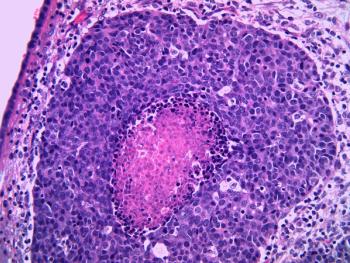
Oncology Overview: Kadcyla for HER2-Positive Breast Cancer
Key Takeaways
- Kadcyla is indicated for HER2-positive metastatic and early breast cancer, especially post-treatment residual disease.
- It carries a black box warning for hepatotoxicity, cardiac toxicity, and embryo-fetal toxicity, requiring careful monitoring.
Ado-trastuzumab (Kadcyla, Genentech) was approved by the FDA in 2019 for the adjuvant treatment of patients with human epidermal growth factor receptor 2-positive early breast cancer.
Ado-trastuzumab (Kadcyla, Genentech) was
It is also indicated for use as an adjuvant treatment of patients with HER2-positive early breast cancer (EBC), for patients who have residual invasive disease, and after they have tried other treatment options, such as taxanes or trastuzumab.¹ Additionally, it's indicated for patients who have developed disease recurrence during or within 6 months of completing adjuvant therapy as well.
HER2-positive breast cancer is one of the most common subtypes of the disease with an age-adjusted rate of 88.1 new cases per 100,000 women, based on the data from 2014 to 2018 cases. This rate is basically 6 times higher than the rate of triple-negative breast cancer and other subtypes.²
Kadcyla comes in a single-dose vial containing 100 mg per vial or a 160 mg dose per vial. This drug should not be substituted with trastuzumab, which is important information for pharmacists to know and to correct if prescribed by practitioners.
It is only administered intravenously (IV) and not by IV push or bolus. It can also not be mixed with dextrose (5%) solution and should only be mixed with 0.9% sodium chloride. The recommended dose for Kadcyla is 3.6 mg/kg body weight, given as IV infusion every 3 weeks, as part of a 21-day cycle, or a total of 14 cycles for each patient with EBC. This drug should not be given at a higher dosage above 3.6 mg/kg as recommended by the manufacturer.¹
Kadcyla is a HER2-targeted antibody conjugate, which is a humanized anti-HER2 immunoglobulin G1, trastuzumab. Upon binding to the HER2 receptor, it results in intracellular release of cytotoxic catabolites, which consequently results in cell cycle arrest and apoptotic cell death.¹
There is a black box warning associated with Kadcyla related to hepatotoxicity, cardiac toxicity, and embryo-fetal toxicity.
Hepatic function should be monitored prior to the initiation of Kadcyla and prior to each dose, as this drug has caused liver failure and death. It should be mentioned that no clinical trials have focused on renal impairment by this drug and its monitoring, and no dose adjustment is recommended for mild (60-89 ml/min) and moderate (30-59 ml/min) renal impairment.
It can also lead to reduction in left ventricular ejection fraction, which again should be monitored. Use during pregnancy can result in embryo-fetal harm, therefore patients should be advised to use effective contraceptives during treatment.¹
Male patients with female partners of reproductive age should also be advised on the proper use of protection to avoid pregnancy. Patients should also be advised against breastfeeding during treatment and 7 months after the last dose of Kadcyla.¹
Additionally, this drug may cause pulmonary toxicity, infusion-related reactions, and hypersensitivity reactions. Fetal cases of hemorrhage have occurred in clinical trials among patients with no history, as well as those with thrombocytopenia history receiving medications such as anti-coagulation or anti-platelet therapy.
For these patients, platelet count should be checked prior to each dose. Finally, if there are any signs of neurotoxicity with this drug, the dose should be discontinued immediately.¹
Adverse effects (AEs) seen from Kadcyla include fatigue, nausea, musculoskeletal pain, hemorrhage, headache, increased transaminases, constipation, thrombocytopenia, peripheral neuropathy, and arthralgia.¹
When it comes to interactions, Kadcyla is metabolized by CYP3A4 as well as by CYP3A5. Concomitant use of strong inhibitors of CYP3A4—such as ketoconazole, itraconazole, clarithromycin, atazanavir, indinavir, ritonavir, and similar drugs—should be avoided because they may cause levels of Kadcyla to increase to toxic levels.¹
In the KATHERINE trial, Kadcyla was used as a single agent at 3.6 mg/kg intravenously every 3 weeks in 1624 patients, including 884 patients with HER2-positive metastatic breast cancer patients and 740 patients with HER2-positive early breast cancer. In the EMILIA trials, 43% of patients experienced grade 3 AEs, of whom, 32 patients (7%) discontinued Kadcyla therapy. The most common AE seen in this trial was the thrombocytopenia, as well as increased transaminases. Dose reduction was performed on approximately 8 patients (16%).¹
When it comes to immunogenicity, a total of 1243 patients from 7 clinical trials were tested for anti-drug antibodies responses to Kadcyla. Upon dosing, 5.1% patients tested positive for anti-Kadcyla antibodies.
In the EMILIA trial, 5.2% of patients tested positive for anti-Kadcyla antibodies, of whom 13 were also positive for neutralizing antibodies. In the KATHERINE trial, approximately 3.7% of patients tested positive for anti-Kadcyla antibodies, 5 of whom were also positive for neutralizing antibodies.¹
Based on the pharmacokinetics studies and their analysis, clearance of Kadcyla was approximately 0.68 L/day and the elimination half-life (t1/2) was approximately 4 days. However, no dose accumulation of Kadcyla was observed after repeated dosing of IV infusion over 3 weeks.
After testing the drug on patients both below and above 65 years of age, as well as on patients of Asian and non-Asian race, these studies concluded that age and race do not have any clinically meaningful impact on the drug’s pharmacokinetics.¹
Pharmacists can play a major role in counseling patients taking Kadcyla. Patients should be informed about liver injury and its signs, such as abdominal pain, jaundice, dark urine, and anorexia. Patients should also be advised on the development of symptoms such as shortness of breath, cough, and swelling of ankles, which would mean possible left ventricular dysfunction.
References
- KADCYLA Prescribing Information (gene.com). Genentech. Accessed September 7, 2021.
https://www.gene.com/download/pdf/kadcyla_prescribing.pdf - National Cancer Institute. Female Breast Cancer Subtypes — Cancer Stat Facts. Accessed September 8, 2021.
https://seer.cancer.gov/statfacts/html/breast-subtypes.html
Updated on September 15, 2021 at 11:33 AM ET
Newsletter
Stay informed on drug updates, treatment guidelines, and pharmacy practice trends—subscribe to Pharmacy Times for weekly clinical insights.

















































































































































































































